When it comes to antique furniture you may come across many different methods of restoration. Some restorers will be in pursuit of a ‘perfect’ finish which fits in with a modern interior – disregarding the historical nature of the piece, whilst others will entirely transform a piece as an upcycling exercise.
At Fine Art Restoration Company we value traditional craftsmanship and treatments, this means that we approach furniture restoration in the same way we would approach a valuable oil painting or sculpture. Our furniture experts come from a background of traditional repairs, choosing to use the very same techniques which would have gone into the original creation of the piece, whether this is original 18th century Chippendale or mid century modern.
In this article we will outline some of the traditional furniture restoration techniques performed by our experts, including the use of era-appropriate materials and the careful consideration given to original marks and unique details.
 Above: a piece of detailed veneer chosen by our team to provide an era appropriate replacement veneer for this piece of antique furniture
Above: a piece of detailed veneer chosen by our team to provide an era appropriate replacement veneer for this piece of antique furniture
Historically accurate furniture materials
When a piece of furniture comes to our studio it is first assessed for the era and style, for example a chair from the Victorian era which can be pinpointed to the arts and crafts movement which we know to be from 1880 to 1920. Based on the style our experts can find a more exact date to focus on, in some cases this allows them to source any missing pieces or veneers from a matching decade. This is the first part in a process of historically accurate restoration, which will see the finished piece in-keeping with the era in which it was originally produced.
 Above: a detail from a cabinet from the Arts and Crafts movement, it was made of oak and tulip poplar in 1904
Above: a detail from a cabinet from the Arts and Crafts movement, it was made of oak and tulip poplar in 1904
The sourcing of wooden features such as backing boards and veneers is often possible with Victorian too early 20th century furniture due to the abundance of these pieces which are available for salvage. In some cases our team can also look for older eras to stay as true as possible to the historical craftsmanship.
 Above: our furniture restoration expert carefully measures out and matches the grain on new veneer details for an antique bureau
Above: our furniture restoration expert carefully measures out and matches the grain on new veneer details for an antique bureau
Brass handles and features including mother of pearl or ivory inlay and marquetry, can also be sourced or handcrafted from appropriate and ethical materials. It is often found that furniture has been modified over the centuries or decades since its creation, leading to original features such as brass handles being lost or replaced with plain wood options – you can see this when a drawer or door has two holes from where the original handle would have been placed. Our team can source era-appropriate handles to bring the restoration back to not only the best state, but the original state beyond the edits made by previous generations. This is often the case with 18th century furniture which has seen original brass handles replaced during the 19th century.
 Above: our furniture expert lining up the woodgrain on a new piece to replace a deteriorating section on this antique cabinet
Above: our furniture expert lining up the woodgrain on a new piece to replace a deteriorating section on this antique cabinet
Our furniture experts pride themselves on the use of bone hide glue and traditional finishes, as mentioned in more detail below. These have been used for hundreds and in some cases thousands of years and they feel it is important to continue the use of tried and tested historical adhesives and varnish in the restoration process.
Handcrafted repairs and tailored treatments
Each piece of wood is cut to size, sometimes over a number of hours if this is an exact veneer detail, such as this herringbone pattern on the side of a 19th century bureau.
Above, our furniture expert Dean carefully matches the grain of the wood, as well as the colour of the original veneer. Not only does this give a visually pleasing finish, but is in-keeping with the artistic and historical style of the work. A successful restoration often requires days of craftsmanship to investigate and repair every aspect and detail in the wood.
Structural instability is a main cause for furniture restoration, common items in our studio include extremely wobbly chairs or unevenly footed tables. Traditional techniques for the restoration of this issue involve completely disassembling and reconstructing the item, whether this is a chair, table, or more unusual structure. This will allow every part to be looked at and repaired before being fitted back together with precision and greater strength where required. Historical glues and finishes will also be used in this process to stay in-keeping with the period or design.
 Above: a new back panel can be added with era-matched wood from sourced and salvaged furniture, above a new panel of similar era has been added – this will later be stained to match the colour of the original
Above: a new back panel can be added with era-matched wood from sourced and salvaged furniture, above a new panel of similar era has been added – this will later be stained to match the colour of the original
Areas where dents, scratches or discolouration has occurred will be examined before determining whether they require or can successfully undergo restoration. This is because some of these features are part of the furniture’s history and show marks of the many centuries it has been in existence, or the everyday love and use of the generations who have owned it. Unless an area has extreme visual or structural disturbance, such as lifting veneers, our experts will often soften the exposure or use gentle techniques to ensure that no marks of age are completely eliminated.
 Above: a selection of stringing veneers from salvaged antiques and various sources ready to be matched to appropriate restoration projects
Above: a selection of stringing veneers from salvaged antiques and various sources ready to be matched to appropriate restoration projects
Traditional varnish and shellac finishes
Historically accurate finishes, such as French polish, wax, and shellac, are a specialism of our furniture team. In our furniture restoration studio you will come across handmade and custom varnishes, as well as ancient forms of adhesives like bone hide glue.
 Above: a selection of traditional tools, adhesives and polishes used in traditional furniture restoration work in our studio
Above: a selection of traditional tools, adhesives and polishes used in traditional furniture restoration work in our studio
The use of traditional glues is important as it is not only in-keeping with tradition, but is a historically tested method which is known to last for hundreds of years. It is also easily removed and replaced by future conservators without damaging the structure, which is important for the preservation of the wood.
Bringing the shine back to the surface of antique wood is a key step in the restoration, as this returns the original finish to an often forgotten woodgrain or veneer pattern which has been hidden for many years or has been affected by a previous disaster.
Above: our furniture expert applying French polish
Such was the case with a William IV extender table which came from a very precise moment in history between Regency and Victorian Britain. The legs received a shellac coating (see video above) and the tabletop was professionally finished with French polish (see video below). This was built up and up for a brilliant shine, before being treated with a fine spirit to produce an even finish.
Our furniture expert would like to share the following care advice for waxing your furniture at home:
“Wax your antique furniture once a month – this will help to build up a resistance to moisture and bring back the original shine. To wax; use sparingly and move with the grain of the wood. Use a soft clean cloth, leave for 4-5 minutes and then buff off. You can use a shoe brush for intricate details and crevices.”
Common damage to antique furniture
The most frequent forms of damage our team come across and restore are the following issues from the environment, old age, or accidental damage:
- Unstable or wobbly chairs and tables
- Uneven table legs
- Scratched and dented surfaces
- Discoloured or faded surfaces
- Snapped and broken legs, backing boards or decorative features
- Stringing and marquetry loss or loosening details
- Loss of original varnish, staining, lacquer, or wax
- Disaster response following floods, leaks or fire
- Accidental damages to the structure or surface
How can we help?
If you have a piece of antique furniture which requires care or traditional furniture restoration treatment from our expert team, please get in touch to speak to our helpful team today.
To make contact please email us via [email protected] or call 0207 112 7576

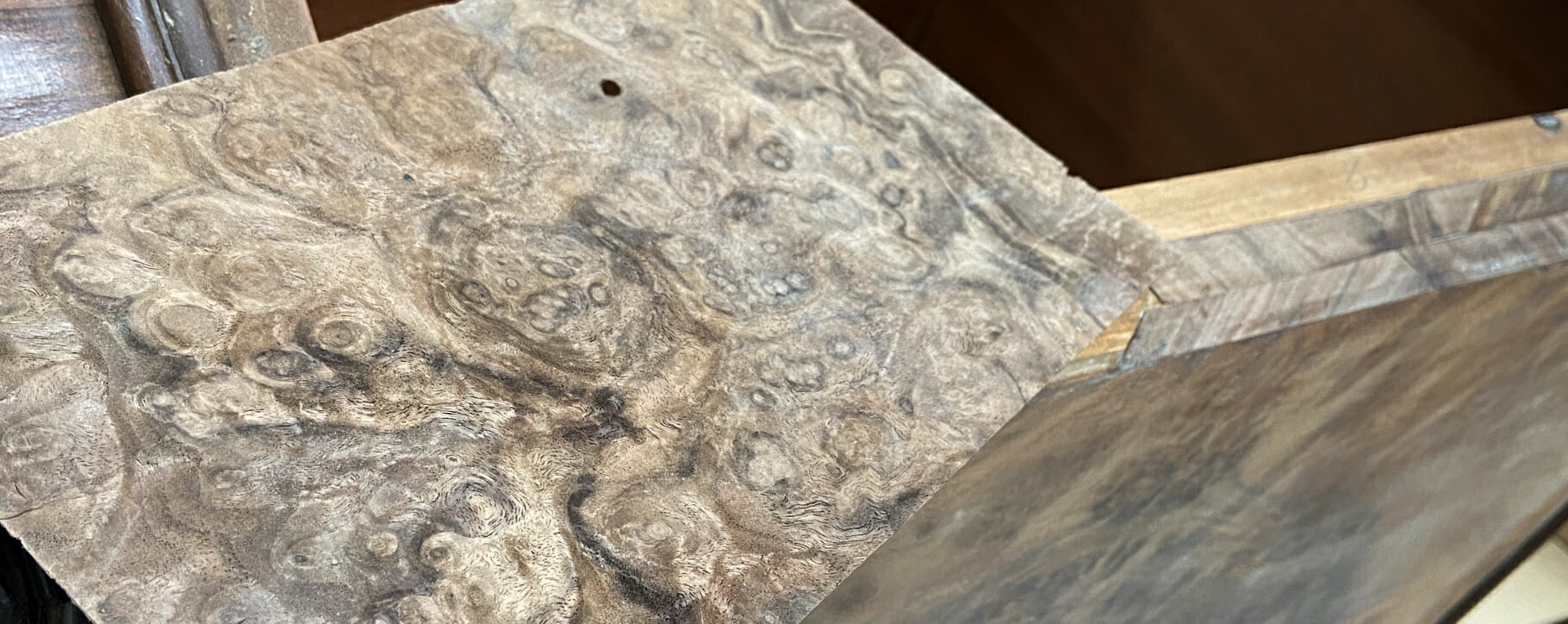 Above: a piece of detailed veneer chosen by our team to provide an era appropriate replacement veneer for this piece of antique furniture
Above: a piece of detailed veneer chosen by our team to provide an era appropriate replacement veneer for this piece of antique furniture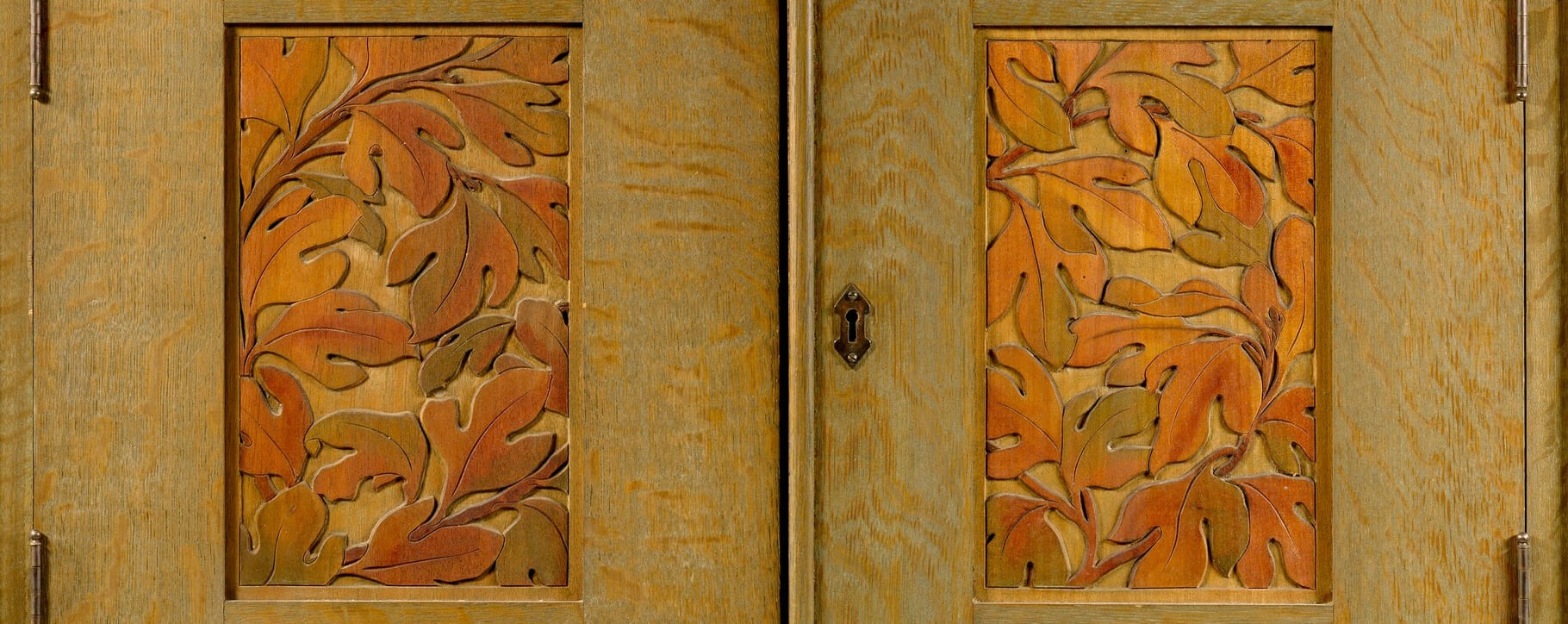 Above: a detail from a cabinet from the Arts and Crafts movement, it was made of oak and tulip poplar in 1904
Above: a detail from a cabinet from the Arts and Crafts movement, it was made of oak and tulip poplar in 1904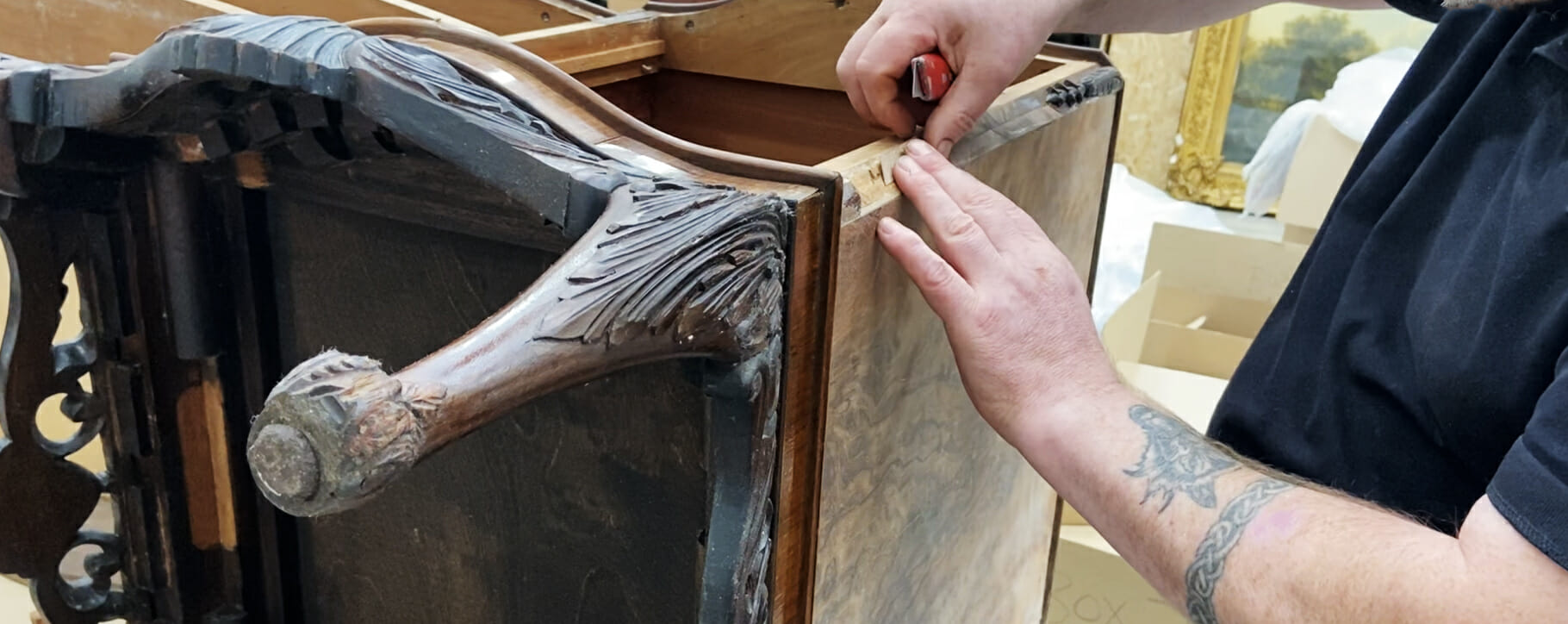 Above: our furniture restoration expert carefully measures out and matches the grain on new veneer details for an antique bureau
Above: our furniture restoration expert carefully measures out and matches the grain on new veneer details for an antique bureau Above: our furniture expert lining up the woodgrain on a new piece to replace a deteriorating section on this antique cabinet
Above: our furniture expert lining up the woodgrain on a new piece to replace a deteriorating section on this antique cabinet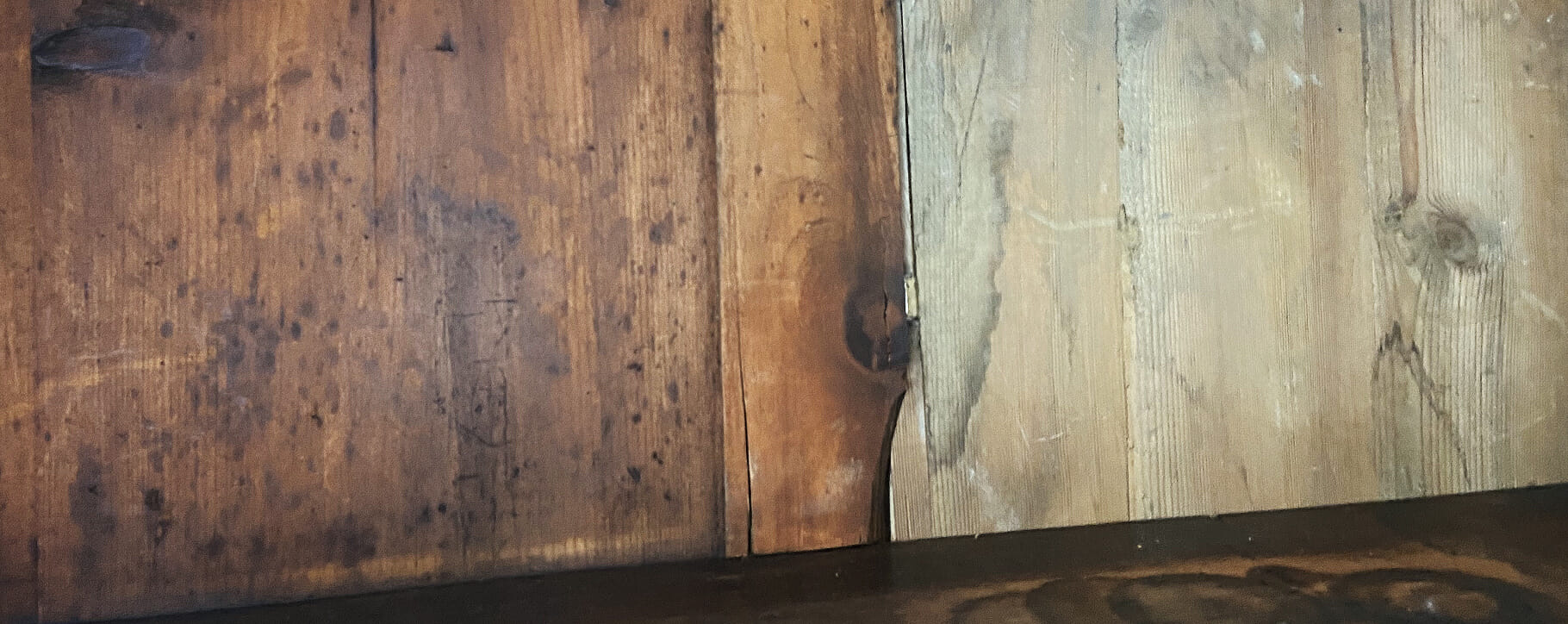 Above: a new back panel can be added with era-matched wood from sourced and salvaged furniture, above a new panel of similar era has been added – this will later be stained to match the colour of the original
Above: a new back panel can be added with era-matched wood from sourced and salvaged furniture, above a new panel of similar era has been added – this will later be stained to match the colour of the original Above: a selection of stringing veneers from salvaged antiques and various sources ready to be matched to appropriate restoration projects
Above: a selection of stringing veneers from salvaged antiques and various sources ready to be matched to appropriate restoration projects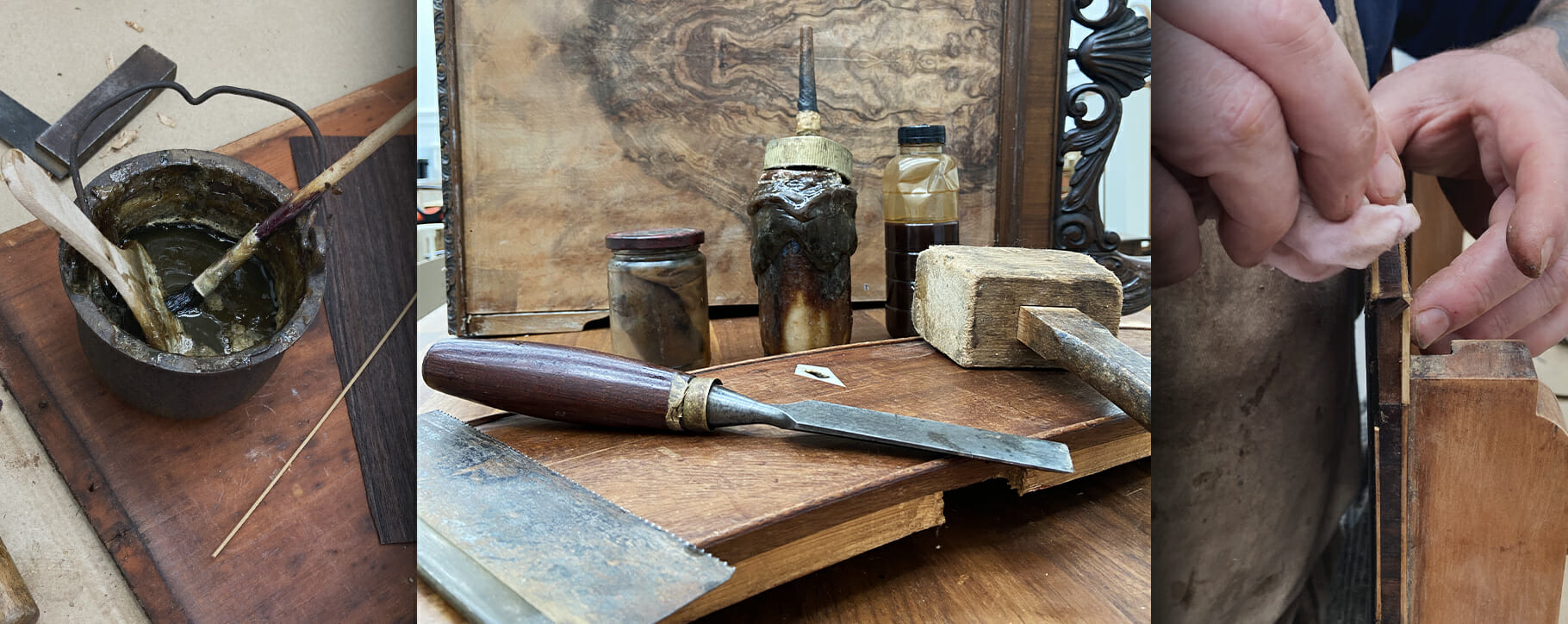 Above: a selection of traditional tools, adhesives and polishes used in traditional furniture restoration work in our studio
Above: a selection of traditional tools, adhesives and polishes used in traditional furniture restoration work in our studio




